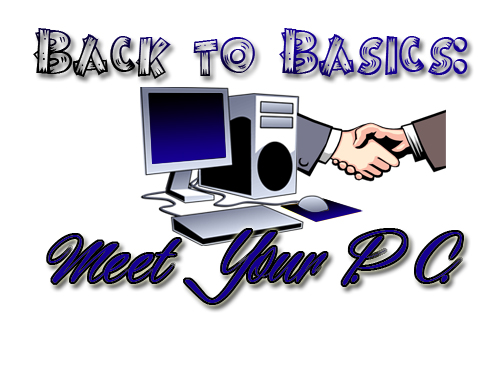
Most of us use a computer every day of our lives. Whether for business or for pleasure, the hours we spend in front of a screen are too numerous to count. It’s almost surprising given all that time together, that must of us have a very slight understanding on what it actually is we’re working on. Our goal in Part 3 of our “Back to Basics” series is to give some insight into the basic workings of the personal computer. We’ll identify the parts and pieces, and identify the purpose that each part brings to the party. Though we’re investigating a desktop computer, these fundamentals will apply to a laptop as well, so laptop users take heart and read on. Don’t worry, we’ll use the KISS method (Keep It Simple, Stupid) and there won’t be a test at the end!
Let’s start with the obvious pieces first: the ones you can see. The monitor is the screen that displays what the computer is actually doing. There’s a power button that turns the monitor on and off, regardless of whether the computer is powered on, and there are two or three cords that hang out of the back. One is the power cord, the second is the cord that connects it to the computer, and the third (not always present) is a wire that connects to the computer to provide sound from internal speakers if the monitor is equipped with them. Monitors come in an infinite number of brands and sizes.
The keyboard is a series of keys that allow the user to input text and commands. Typically there is only one wire connecting the keyboard to the computer, with either a rectangular USB port on the end, or a purple “round” plug (PS/2). The PS/2 plug is old technology now with the majority of keyboards USB. Many keyboards are now wireless, with a USB antenna plugged into the computer and a switch on the keyboard to turn it on or off. The keys on the keyboard are arranged in what’s called the QWERTY configuration. Look at the letters on the fourth row from the bottom and you’ll see why.
The purpose of the mouse is to control the cursor on the computer monitor. When you move the mouse, an arrow will appear. If you pick the mouse up and then set it back down, the arrow will not move. There are one or two buttons on the mouse that when clicked are called a “left click” or a “right click”. You’ll use a left click most of the time. If you click the left button twice (double-click) you can open a program or file on the computer. A right click will open a menu giving you more options. The mouse has the same connection options as the keyboard, except the “round” PS/2 port is green.
That brings us to the computer itself. You might hear the computer referred to as the CPU. Technically, the CPU (central processing unit) is the processor inside the computer which acts as the brain of the computer. I call the computer the tower. Whatever you call it, it’s the box where the magic happens. Everything gets plugged into the computer (tower) – all “peripherals” such as mouse, keyboard, monitor, speakers, network wire, printer, etc. If you were to take the cover off your computer, you’d see the board that all the wires are connected to. That board is called the motherboard. The small chip with its own fan and heat sink is the CPU. The larger box with a fan with all the plugs running in different directions is the power supply. A cord gets plugged into the back of it, and the other goes into the wall or power strip to give your computer the juice to run all this stuff. You’ll see anywhere from one to four plastic strips snapped into the motherboard. Those are your RAM modules which give your computer memory. Those aren’t to be confused with the hard drive that stores all the programs and files on the computer. That’s typically near the top of the tower and below the CD/DVD drive. When you look at the back of the computer, you’ll notice the ports we talked about earlier to connect everything to the computer. Many of these are color coded to simplify things. Most ports are now of the rectangular USB variety.
It’s important to have some level of understanding into what makes a computer tick. If nothing else, it’ll be easier to describe to a tech if (when) you run into problems. It really doesn’t matter how savvy you are, there will be problems! I’m not perfect. Heck, I spilled a glass of water on my computer once! Anyway, you don’t have to be an expert, but you don’t have to be afraid of your computer either. Whether you just bought it, or have had it for five years, now is the perfect time to Meet Your Computer.
